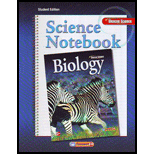
Concept explainers
To define:
The given terms using a book or a dictionary.
Introduction:
Humans, apes, lemurs and monkeys are called primates. They share some general features such as high level of manual dexterity, keen eyesight, long, movable arms, and large brains. The primates with large brains have the capacity to reason.
Answer to Problem 3MI
Opposable first digit- A thumb or a great toe that is set apart from other fingers or toes and can be brought across the palm or foot so that it touches other digits.
Binocular vision- Overlapping field of vision is called binocular vision.
Diurnal −A creature that is active during daytime is called diurnal.
Nocturnal - A creature that is active during nighttime is callednocturnal.
Arboreal −An animal that lives on tree is called arboreal.
Anthropid- It refers to human like primate that seems to be more closely related to present day humans than it is to present day chimpanzees and bonobos.
Prehensile tail-A tail that functions as a fifth limb is called prehensile tail.
Hominin- It refers to the human like primate.
Explanation of Solution
- An opposable first digit- The first digits on most primates’ hands and feet are opposable. An opposable thumb or toe is different from other digits. It can be brought across the palm or foot so that it touches the other digits. This action helps the primate to grasp an object in a powerful grip. This adaptation helps the primate to live on trees as they can firmly grasp the branches and their food with opposable thumbs and toes.
- Binocular vision- The primates have eyes protected inside bony eye sockets. The eyes are located on the front of their face. This creates an overlapping field of vision called the binocular vision. This This adaptation helps the primate to live on trees as it allows for a greater field of depth perception and enables the primate to judge relative distance and movement of an object.
- Diurnal − Most primates are diurnal; that is they are active during daytime. Because they are active during the day they also have color vision.
- Nocturnal −Some primates are active during nighttime. They are callednocturnal. They can only see in black and white.
- Arboreal − An animal that lives on tree is called arboreal. Primates are a large group of more than 200 species. Most of them are tree dwelling or arboreal. They live mostly in tropical and subtropical forests.
- Anthropid-Primates are classified into two groups based on features of their nose, eyes and teeth. The strepsirrhines or the “wet nosed” primates are the earliest of the primates. Lemurs belong to this group. The other group is called “dry nosed” primates or haplorhines. These include the anthropoids which are human like primate that seems to be more closely related to present day humans than it is to present day chimpanzees and bonobos.
- Prehensile tail-The New World monkeys which include the squirrel monkeys, spider monkeys and capuchin monkeys have a tail that functions as a fifth limb. It is called prehensile tail. The tail can grasp branches of tree and can support the weight of monkey.
- Hominin- It refers to the human like primate. The group includes humans and all their extinct relatives.
Additional Science Textbook Solutions
Genetic Analysis: An Integrated Approach (2nd Edition)
Biology: Life on Earth (11th Edition)
Campbell Essential Biology with Physiology (6th Edition)
Fundamentals of Anatomy & Physiology (11th Edition)
Human Physiology: An Integrated Approach (8th Edition)
Brock Biology of Microorganisms (14th Edition)
 Human Anatomy & Physiology (11th Edition)BiologyISBN:9780134580999Author:Elaine N. Marieb, Katja N. HoehnPublisher:PEARSON
Human Anatomy & Physiology (11th Edition)BiologyISBN:9780134580999Author:Elaine N. Marieb, Katja N. HoehnPublisher:PEARSON Biology 2eBiologyISBN:9781947172517Author:Matthew Douglas, Jung Choi, Mary Ann ClarkPublisher:OpenStax
Biology 2eBiologyISBN:9781947172517Author:Matthew Douglas, Jung Choi, Mary Ann ClarkPublisher:OpenStax Anatomy & PhysiologyBiologyISBN:9781259398629Author:McKinley, Michael P., O'loughlin, Valerie Dean, Bidle, Theresa StouterPublisher:Mcgraw Hill Education,
Anatomy & PhysiologyBiologyISBN:9781259398629Author:McKinley, Michael P., O'loughlin, Valerie Dean, Bidle, Theresa StouterPublisher:Mcgraw Hill Education, Molecular Biology of the Cell (Sixth Edition)BiologyISBN:9780815344322Author:Bruce Alberts, Alexander D. Johnson, Julian Lewis, David Morgan, Martin Raff, Keith Roberts, Peter WalterPublisher:W. W. Norton & Company
Molecular Biology of the Cell (Sixth Edition)BiologyISBN:9780815344322Author:Bruce Alberts, Alexander D. Johnson, Julian Lewis, David Morgan, Martin Raff, Keith Roberts, Peter WalterPublisher:W. W. Norton & Company Laboratory Manual For Human Anatomy & PhysiologyBiologyISBN:9781260159363Author:Martin, Terry R., Prentice-craver, CynthiaPublisher:McGraw-Hill Publishing Co.
Laboratory Manual For Human Anatomy & PhysiologyBiologyISBN:9781260159363Author:Martin, Terry R., Prentice-craver, CynthiaPublisher:McGraw-Hill Publishing Co. Inquiry Into Life (16th Edition)BiologyISBN:9781260231700Author:Sylvia S. Mader, Michael WindelspechtPublisher:McGraw Hill Education
Inquiry Into Life (16th Edition)BiologyISBN:9781260231700Author:Sylvia S. Mader, Michael WindelspechtPublisher:McGraw Hill Education





